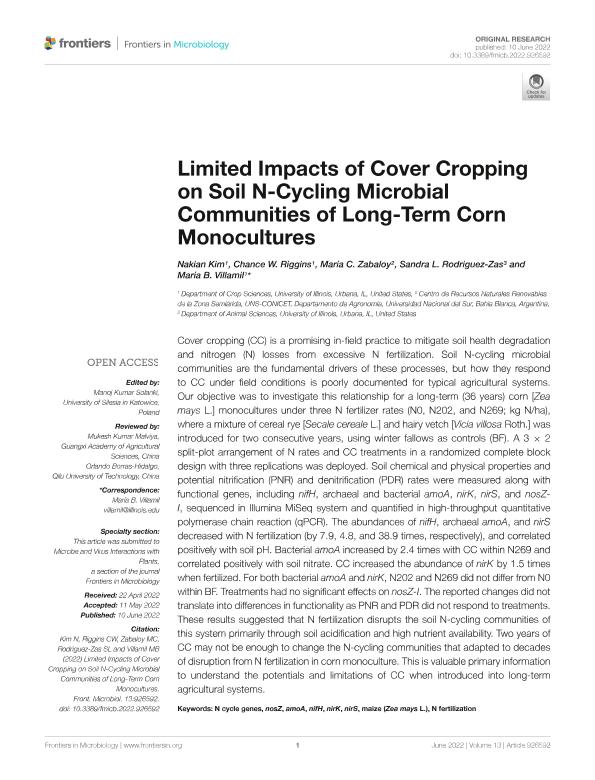Artículo
Limited Impacts of Cover Cropping on Soil N-Cycling Microbial Communities of Long-Term Corn Monocultures
Kim, Nakian; Riggins, Chance W.; Zabaloy, Maria Celina ; Rodriguez Zas, Sandra L.; Villamil, Maria Bonita
; Rodriguez Zas, Sandra L.; Villamil, Maria Bonita
 ; Rodriguez Zas, Sandra L.; Villamil, Maria Bonita
; Rodriguez Zas, Sandra L.; Villamil, Maria Bonita
Fecha de publicación:
10/06/2022
Editorial:
Frontiers Media
Revista:
Frontiers in Microbiology
e-ISSN:
1664-302X
Idioma:
Inglés
Tipo de recurso:
Artículo publicado
Clasificación temática:
Resumen
Cover cropping (CC) is a promising in-field practice to mitigate soil health degradation and nitrogen (N) losses from excessive N fertilization. Soil N-cycling microbial communities are the fundamental drivers of these processes, but how they respond to CC under field conditions is poorly documented for typical agricultural systems. Our objective was to investigate this relationship for a long-term (36 years) corn [Zea mays L.] monocultures under three N fertilizer rates (N0, N202, and N269; kg N/ha), where a mixture of cereal rye [Secale cereale L.] and hairy vetch [Vicia villosa Roth.] was introduced for two consecutive years, using winter fallows as controls (BF). A 3 × 2 split-plot arrangement of N rates and CC treatments in a randomized complete block design with three replications was deployed. Soil chemical and physical properties and potential nitrification (PNR) and denitrification (PDR) rates were measured along with functional genes, including nifH, archaeal and bacterial amoA, nirK, nirS, and nosZ-I, sequenced in Illumina MiSeq system and quantified in high-throughput quantitative polymerase chain reaction (qPCR). The abundances of nifH, archaeal amoA, and nirS decreased with N fertilization (by 7.9, 4.8, and 38.9 times, respectively), and correlated positively with soil pH. Bacterial amoA increased by 2.4 times with CC within N269 and correlated positively with soil nitrate. CC increased the abundance of nirK by 1.5 times when fertilized. For both bacterial amoA and nirK, N202 and N269 did not differ from N0 within BF. Treatments had no significant effects on nosZ-I. The reported changes did not translate into differences in functionality as PNR and PDR did not respond to treatments. These results suggested that N fertilization disrupts the soil N-cycling communities of this system primarily through soil acidification and high nutrient availability. Two years of CC may not be enough to change the N-cycling communities that adapted to decades of disruption from N fertilization in corn monoculture. This is valuable primary information to understand the potentials and limitations of CC when introduced into long-term agricultural systems.
Palabras clave:
AMOA
,
MAIZE (ZEA MAYS L.)
,
N CYCLE GENES
,
N FERTILIZATION
,
NIFH
,
NIRK
,
NIRS
,
NOSZ
Archivos asociados
Licencia
Identificadores
Colecciones
Articulos(CERZOS)
Articulos de CENTRO REC.NAT.RENOVABLES DE ZONA SEMIARIDA(I)
Articulos de CENTRO REC.NAT.RENOVABLES DE ZONA SEMIARIDA(I)
Citación
Kim, Nakian; Riggins, Chance W.; Zabaloy, Maria Celina; Rodriguez Zas, Sandra L.; Villamil, Maria Bonita; Limited Impacts of Cover Cropping on Soil N-Cycling Microbial Communities of Long-Term Corn Monocultures; Frontiers Media; Frontiers in Microbiology; 13; 926592; 10-6-2022; 1-16
Compartir
Altmétricas



